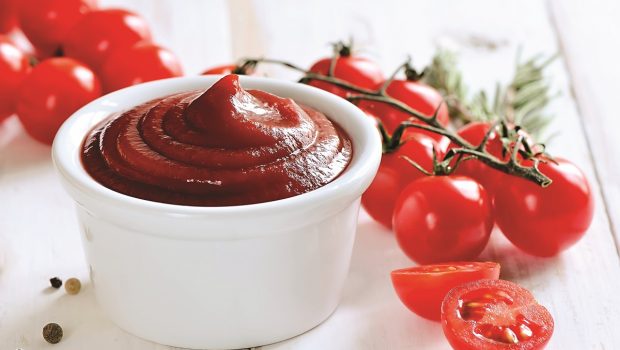CRAZY-GOOD CONDIMENTS
DIY Versions Add Zest and Nutrients
by Judith Fertig
While not essential to every dish or meal, condiments provide extra fl avoring, fi nal fl ourishes and added enjoyment to any dish. Such meal accompaniments range from vinegars to spreads and sauces, fi nishing spice mixtures and natural salts.
America’s previous king of condiments was ketchup. Today, according to a 2017 poll from The DailyMeal.com, it stands behind mayonnaise and mustard with soy and hot sauce rounding out the top fi ve (generic product ranking at Tinyurl.com/ Top20Condiments).
We often take familiar condiments for granted, yet a look at their ingredients can be startling. Many prominently include processed corn syrup and other sugars, sodium, gluten, monosodium glutamate (MSG), artificial flavors and unpronounceable preservatives, according to Dana Angelo White, a registered dietitian in Fairfield, Connecticut.
Homemade versions of condiments provide a happy alternative. They not only taste great, but can be good for us. “Certain condiments add more to your meals than flavor—some actually improve your health,” says White. Th e potassium in homemade mustard is good for the digestive system through stimulating the fl ow of saliva, suggests a study in the Indian Journal of Medical Research. Homemade ketchup made with small cooked tomatoes is rich in lycopene, a nutrient that protects heart health, according to research published in the American Journal of Clinical Nutrition. White’s fresh-made “THE Green Sauce,” full of vitamin-rich avocado and cilantro, is replete with antioxidants (Tinyurl.com/TheGreenSauceRecipe).
Better Basics
Ketchup
Heather McClees, a plant-based nutritionist in South Carolina who blogs at One Green Planet, once loved commercial ketchup; then she read the labels. “Most ketchup is made of tomato concentrates, sugars, including high-fructose corn syrup, cane sugar, agave nectar, coconut nectar/syrup, brown rice syrup, cane juice and cane crystals, vinegar, “spices” that is likely code for MSG, water and refined salt. All of this makes ketchup addicting,” she says.
“While you could pay for pricey organic ketchup and condiments that come without added sugars, you can save money by spending five minutes in the kitchen to make your own.” Find a recipe at Tinyurl.com/HealthyKetchupRecipe.
Mustard
Serious Eats food writer Joshua Bousel uses only six ingredients to make a deliciously easy Grainy Mustard: yellow and brown mustard seeds, dry white wine, white wine vinegar, kosher salt and an optional pinch of brown sugar. Learn how at Tinyurl.com/ WholeGrainDijonRecipe.
Mayonnaise and Ranch Dressing
Eschewing eggs, J. Kenji Lopez-Alt, of San Mateo, California, uses aquafaba, the starchy liquid in a can of chickpeas, for a plant-based twist on emulsified mayonnaise. Find it at Tinyurl.com/AquafabaMayoRecipe.
In her Mebane, North Carolina, kitchen, Kim Campbell, author of The PlantPure Kitchen, makes a plant-based ranch dressing with tofu for body and nutritional yeast, herbs and lemon juice to achieve the characteristic flavor. Find it at Tinyurl.com/HealthyRanchDressing.
More Exotic Condiments
Pomegranate Molasses
Sweet and tart pomegranate molasses can be used like vinegar in salad dressings, as a marinade ingredient or as syrup over pancakes and waffles. Angela Buchanan, aka Angela Cooks, a professor at the University of Colorado, in Boulder, who blogs at SeasonalAnd Savory.com, follows the Whole30 program, which bars sugar. Because she also likes Middle-Eastern food, Buchanan experimented and created her recipe for Pomegranate Molasses without added sugar (Tinyurl.com/PomegranateMolassesRecipe).
Superfood Popcorn Seasoning
Green popcorn is fun. With a spirulina powder, garlic powder, sea salt and cayenne pepper spice mix, even a movie snack can be healthy. “Spirulina is one of the most potent of all superfoods. Available in a powder form, it’s a blue-green algae that provides protein, B vitamins and iron. It’s used as a natural energizer, digestive aid and detoxifier,” says Tara Milhern, a holistic health coach in New York City. She also likes it sprinkled on baked potatoes or vegetables as a finishing flavor. See Tinyurl.com/HealthyPopcornSeasoning.
Without preservatives, homemade healthy condiments don’t last as long as commercial versions. McClees advises, “I store mine in a glass mason jar for one week in the fridge. I choose a half-pint-size jar, since the less empty space there is at the top of the jar, the longer it keeps.”
Judith Fertig writes cookbooks plus foodie fiction from Overland Park, KS (JudithFertig.com).
Image: Fortyforks/Shutterstock.com




























